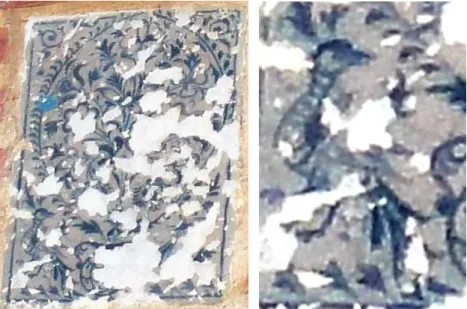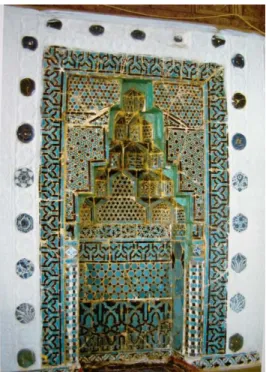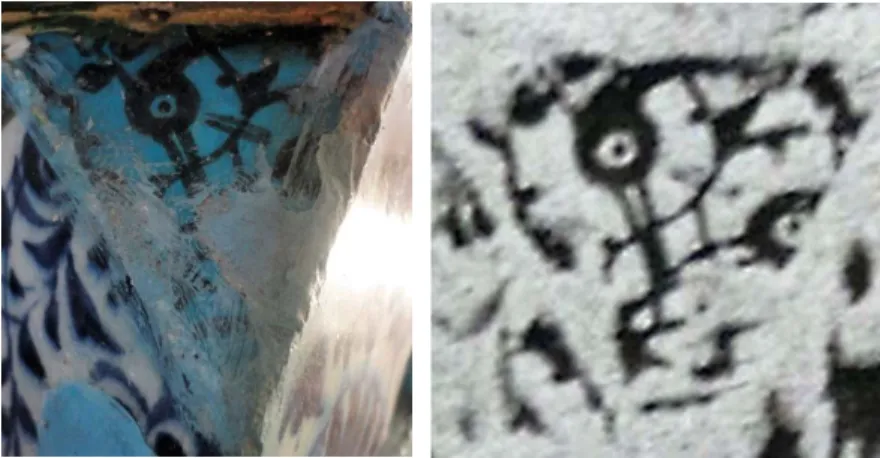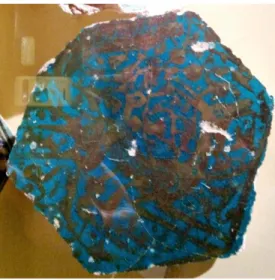ARCHITECTURAL TILES OF THE KARAMANIDS DECORATED WITH
ANIMAL FIGURES
MİNE ERDEM Res. Assist., Selcuk University Department of Ancient Tile Repair mina_rdm@hotmail.com
ABSTRACT
The Karamanids were the most important principality among the Anatolian principalities (beyliks). They attempted to promote integrity and solidarity during the period between the 12th and 15th centuries, when social welfare was not ensured in these territories. The importance placed by the principality on the tile art during this period is clearly apparent from the examples of tiles which they used to decorate buildings of Karamanid architectural design. It was also observed that the tiles decorated with animal figures are limited. More so than animal figures, the architectural tiles of the Karamanids were decorated with floral, geometric and writing patterns. Therefore, these tiles represent the varied examples and the differences among the tiles of the principality. The tiles with animal figures were found to have pictures of birds, including swans, and gazelle (deer). The animal figures were applied on the hexagonal and triangular plate-type tiles, using the techniques of luster, blue-white and under-glaze. The artwork of the tiles which were used for the interior and exterior decoration of the buildings of Karamanid architectural design are observed to be highly influenced by the Palace tiles of the Seljuk period. It was discovered that the Ottoman-period tiles were less influential. The tiles with figures in which animals are portrayed in their natural setting are different from the other tiles found in the buildings of Karamanid architectural design. Their forms are different, as well as the techniques used for their application. This has created serious questions regarding whether the tiles with figures found in the Karamanid buildings actually originated there. The animal figures, each of which has a different symbolic value, are also very important among the tiles of the Karamanids. Among the tiles of the Karamanids, the tiles with animal figures enriched and offered variety by means of their forms and application techniques. It is important to conduct research on this topic, in order to examine their importance in Turkish tile art, and determine their value. The main factor in the selection of this topic is the fact that no detailed research has been conducted on the Karamanid principality's tiles with animal figures.
_____________________________________________________ART-SANAT 7/2017_____________________________________________________
HAYVAN FİGÜRLERİYLE BEZELİ KARAMANOĞLU BEYLİĞİ MİMARİ
ÇİNİLERİ
ÖZ
Anadolu topraklarında, toplumsal refahın tam olarak sağlanamadığı 12-15. yy. kapsayan dönemde, birlik ve bütünlüğü sağlama çabasıyla mücadele eden Beyliklerin başında Karamanoğulları gelmektedir. Böyle bir dönemde, Beyliğin çini sanatına verdiği önem mimari yapılarını bezemede kullanmış oldukları çinili örneklerle anlaşılmaktadır. Bitkisel, geometrik ve yazı motifleriyle bezenmiş Karamanoğlu Beyliği mimari çinilerinde, hayvan figürleriyle bezeli olanların az miktarda olduğu anlaşılmıştır. Bu nedenle bu çiniler, Beyliğin çinileri içinde farklılık oluşturan örneklerin temsilcileri olmuştur. Çinilerde kullanılan hayvan figürlü motiflerin; kuş, kuğu ve ceylan (geyik) olduğu belirlenmiştir. Hayvan figürleri; dikdörtgen, altıgen ve üçgen formlu plaka çiniler üzerine; lüster, mavi beyaz ve sır altı tekniklerinde uygulanmıştır. Karamanoğlu Beyliği mimari iç ve dış cephe bezemesinde kullanılmış olan figürlü çinilerde büyük oranda Selçuklu dönemi Saray çinilerinin etkisi görülmüştür. Osmanlı dönemine ait çinilerin izleri ise daha az orandadır. Doğadaki halleriyle tasvir edilmiş olan figürlü çiniler uygulanmış oldukları mimari yapılardaki diğer çiniler içinde farklı teknik ve formlarda olmaları nedeniyle farklılık oluşturmuşlardır. Bu da bizlere figürlü çinilerin bulundukları mimari yapıya aitliğini sorgulatmıştır. Her biri farklı sembolik değerlere sahip olan hayvan figürleri, Karamanoğlu Beyliği çinileri içinde önem teşkil etmektedir. Sahip oldukları teknik ve formlarla Karamanoğlu Beyliği çinilerine zenginlik ve çeşitlilik kazandıran hayvan figürlü çiniler Türk çini sanatı içindeki yerinin belirlenmesi ve değerini gösterebilmesi için incelenmesi gereken önemli bir araştırma konusudur. Beyliğin hayvan figürleriyle bezeli çinileriyle ilgili detaylı çalışmanın yapılmamış olması, bu konuyu seçmemizde temel etken olmuştur.
Anahtar Kelimeler; Karamanoğlu Beyliği, çini, hayvan figürleri.
INTRODUCTION
The research concluded that the architectural tiles of the Karamanids period were primarily produced through the application of the faience mosaic technique. It was also observed that only a small number of the tiles decorated with animal figures were used. Therefore, the tiles decorated with animal figures stood out from the other tiles, and drew more attention. The patterns used on the tiles were found to be that of the bird, the swan and the gazelle (deer). Even though it was reported that there was a tile with a fox pattern, it does not exist today (Arık, Arık 2007: 288). The Aksehir Seyid Mahmud Hayrani Tomb, the Kazimkarabekir Ulu Mosque and the Yollarbasi Ulu Mosque, which are among the buildings of Karamanid architectural design, were also found to have tiles with animal figures. These specified tiles were examined together with the characteristics of the architectural design of the buildings in which they were discovered.
The Seyid Mahmud Hayrani Tomb consists of two parts. The Tomb, which is square, is covered with a ten-hexagonal plate-type body and cone (Aslanapa 2003: 207). There are rectangular plane niches on the surface of the ten-hexagonal plate-type body (Fig. 1).
Fig. 1 Seyid Mahmud Hayrani Tomb.
A rectangular plate tile was applied on one of the niches using the 15th and 16th century blue-white technique (Dülgerler 2006: 170). A pattern with a bird figure appears on the lower left side of the tile, which was decorated with blue on the white surface (Fig. 2). It was discovered that among the animal figure tiles of the Karamanids, only the tile with the bird figure in the Hayrani tomb has characteristics which are similar to those which were applied with the 15th and 16th century blue-white technique of Ottoman period. The figure draws attention with its long tail, short beak and linear decors extending from its neck to its body.
_____________________________________________________ART-SANAT 7/2017_____________________________________________________
The bird was regarded as the symbol of the sky, drifting away from the world, lightness, spiritual elements, intuition and inspiration, and the intermediation between sky and land (Salt 2010: 228). In Christian art, birds were used as the symbol of the soul with wings. The depiction of birds symbolizing the soul dates back to ancient Egypt (Ferguson 1966: 12).
The Kazimkarabekir Ulu Mosque in the Kazimkarabekir District of Karaman Province is in the direction of north-south, and rectangular in width (Fig. 3). The sanctuary with four sahns (a courtyard in Islamic architecture) which are parallel to the mihrab (niche of a mosque indicating the direction of mecca) is covered with a flat roof (Temizsoy, Uysal 1981).
Fig. 3 Kazimkarabekir Ulu Mosque.
Hexagonal plate-type tiles, which exist today, decorated with bird and deer (gazelle) patterns using the luster technique, were discovered on the old mihrab border of the mosque (Fig. 4). Also, an example of a tile which was decorated with two bird patterns using the under-glaze technique was discovered on the lamina capital of the mihrab pilaster (Yetkin 1986: 135).
Fig. 4 The old mihrab border (Arık, Arık 2007: 176).
The hexagonal plate-type tiles on the old mihrab border are now in the Sahip Ata museum and in storage at the Karatay museum in Konya. One of the tiles exhibited in the Sahip Ata museum was decorated with a motif reminiscent of a bird of prey. It was applied in turquoise glaze using the luster technique (Fig. 5).
Fig. 5 The old mihrab border tile in Ulu Mosque.
It is stated that the bird figure in this example represents Ongun (a bird of prey) of the Karamanids. It is believed that four of the Oghuz tribes had the ongun. The animals called "ongun" included birds of prey such as the hawk, eagle and goshawk. The onguns of Oghuz tribes originated from falcons (Öner 2008: 555).
_____________________________________________________ART-SANAT 7/2017_____________________________________________________
Fig. 6 The tile with a bird pattern and its drawing (Oral 1964: 32).
There is a hexagonal plate-type tile with a swan motif which appears on the old mihrab border of the Kazimkarabekir Ulu mosques. It is now preserved and in storage at the Karatay museum in Konya (Fig. 6). The tile was decorated with a swan figure by using the technique of applying matt gilt colored luster on the turquoise glaze (Oral 1964: 32).
The tile on the capital of the mihrab pilaster is still in its original location. A photograph which was previously discovered (Yetkin, 1986) makes it apparent that the triangular tile was decorated with two bird figures, whose beaks are in contact with each other, by applying the black color under the turquoise blue transparent glaze (Fig. 7). Their long necks and round eyes are the remarkable features of these birds.
Fig. 7 The tile on the capital of mihrab pilaster of the Ulu Mosque and its photograph.
(Yetkin 1986: 299)
The examination of all of the old border tiles around the mihrab in the Kazimkarabekir Ulu Mosque demonstrates that the 12th-13th century Seljuk influence is apparent on these tiles.
It was observed that there is a deer (gazelle) figure on one of the old border tiles around the mihrab in the Ulu Mosque. The figure depicted the deer running, as it would in
nature (Fig. 8). The remarkable features of the figure are its short horns, long tail, and being depicted as if in motion. The figure was applied on a hexagonal plate-type tile which was covered with a single color turquoise glaze by using the luster technique. It was surrounded by floral motifs.
Fig. 8 The tile with a deer motif.
The deer is regarded as a sacred animal in Turkish history. The deer, which represents the night in ancient Turkish beliefs, is one of the important symbols of derivation. In Turkish mythology, some appeared disguised as a deer, as observed in the Anatolian epics (Duran 2012: 122). It is narrated that Geyikli Baba (Father who has deer) that have a sentimental value disguises himself as a deer. The mount of some sheikhs was a deer. Also, the deer horn was used against the evil eye, and was regarded as a symbol of abundance and plenty (Çoruhlu 2011: 166).
The Yollarbasi Ulu Mosque in the Yollarbası town of Karaman Province is in the direction of north-south and rectangular in plan. The sanctuary with three sahns parallel to the mihrab is covered with an earthen roof (Fig. 9), (Diez, Aslanapa, Koman 1950: 101).
_____________________________________________________ART-SANAT 7/2017_____________________________________________________
There is a tile decorated with a peacock motif on the plaster mihrab of the mosque. The tile, half of which was broken, was decorated by using the under-glaze technique (Fig. 10). The figure was painted with black and cobalt colors on the plate-type tile, which was considered hexagonal.
Fig. 10 The mihrab and the tile with the peacock motif
The peacock was regarded as a symbol of not only nobility and aristocracy, but also sovereignty, because the peacock figure was displayed during the coronations of emperors (Esin 1978: 92).
The example of tile with a peacock in the mihrab of Yollarbasi Ulu Mosques reminded us the examples of tiles available in the Palace buildings of Seljuk period which were decorated by using the under-glaze technique.
CONCLUSION
Even though the architectural tiles of the Karamanids period which were decorated with animal figures were damaged over time, the figures on them can still be clearly seen. The figures of swans, birds and gazelle (deer) were applied on the hexagonal, triangular and rectangular plate-type tiles by using the blue-white, luster and under-glaze techniques.
The tile decorated with a bird figure through the use of the blue-white techniques found in the Seyid Mahmud Hayrani Tomb was applied to the niche part on the upper wall outside of the Tomb. The tiles with bird and gazelle motifs in the Kazimkarabekir Ulu Mosque were located on the old mihrab border, and on the lamina capital of the mihrab pilaster. The tile with the bird motif in the Yollarbasi Ulu Mosque was applied to the niche of the mihrab. The fact that these tiles with animal figures were applied by using techniques different from other tiles which decorated the entire buildings of the Karamanid architectural design, and that they are not in harmony with the architecture of the buildings, questions whether these tiles belong to the Karamanids. The fact that nearly
all of the tiles covering the mihrab of the Kazimkarabekir Ulu Mosque were decorated with the mosaic technique, and that the tiles with figures were decorated using the under-glaze and luster techniques, is a good example of why this questioning is being raised. Similarly, the use of tiles with figures in the Seyid Mahmud Hayrani Tomb, the Yollarbasi Ulu Mosque and the Kazimkarabekir Ulu Mosque is a topic that should be thoroughly examined, with this question in mind.
The examination of the techniques used in the application of the Karamanids tiles with animal figures demonstrated that - except for the tile in the Seyid Mahmud Hayrani Tomb - which was decorated with the bird motif through the use of the blue-white technique under the influence of the Ottoman Empire, all tiles with animal figures were influenced by the Seljuks. It is normal for the arts of the Karamanids, the Seljuks and the Ottoman Empire - which ruled over the same area during the same period - to be similar. Because the similar tiles with animal figures were found in the buildings of the architectural design of the Karamanids, they are regarded as the tiles of this principality.
_____________________________________________________ART-SANAT 7/2017_____________________________________________________





